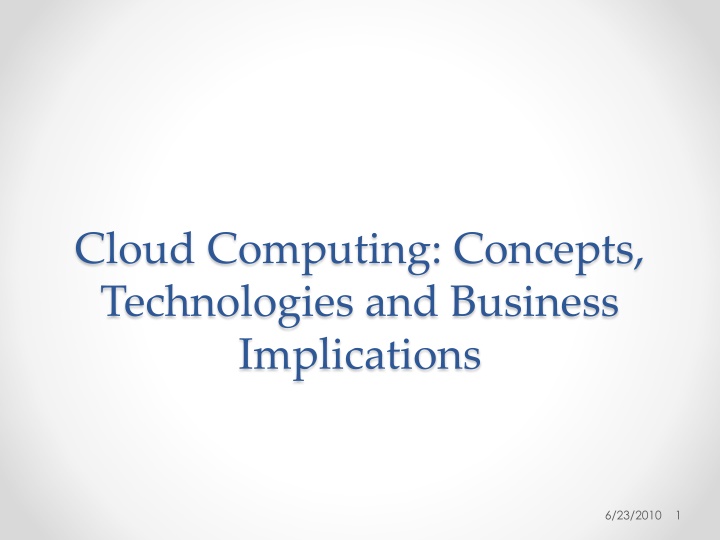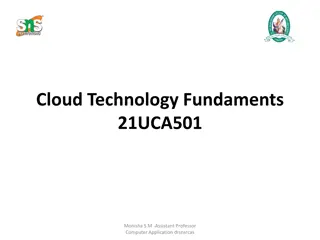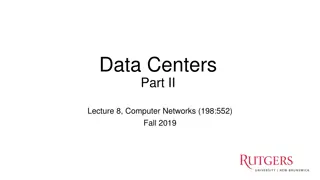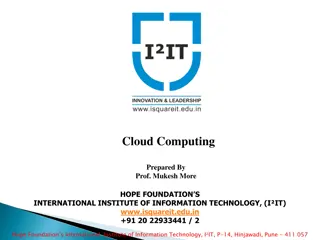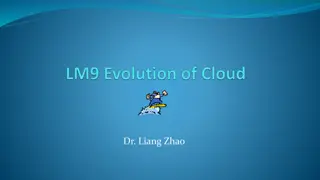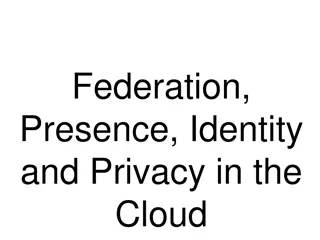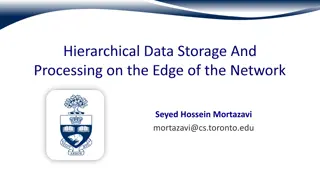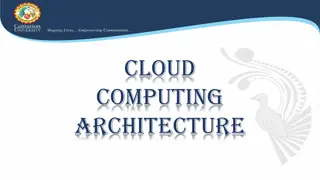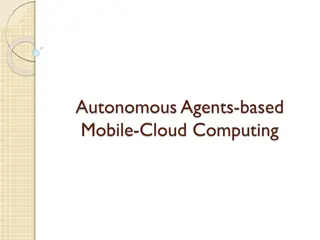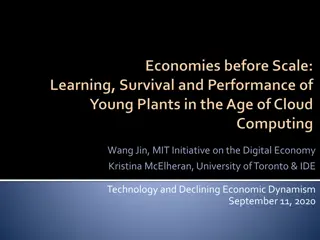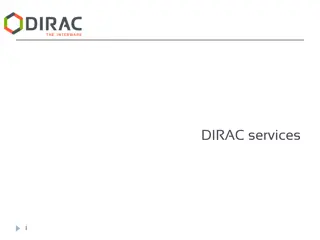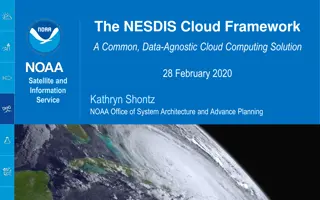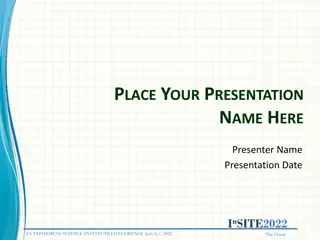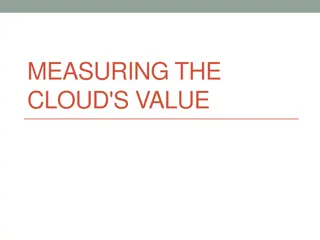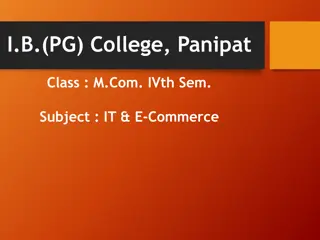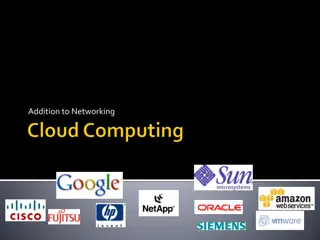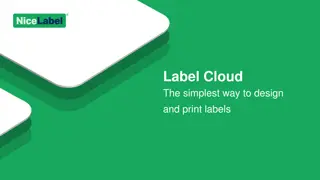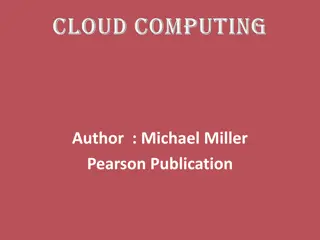Overview of Cloud Computing Technologies and Business Implications
Explore the concepts, technologies, and business implications of cloud computing through a discussion on multi-core processors, virtualization, cloud service models (IaaS, PaaS, SaaS), data processing models like MapReduce, and real-world case studies. Learn about the evolution of internet computing, large databases, and the exciting possibilities that the cloud offers. Presented by distinguished speakers with significant contributions to cloud computing research and practice.
Uploaded on Oct 10, 2024 | 0 Views
Download Presentation

Please find below an Image/Link to download the presentation.
The content on the website is provided AS IS for your information and personal use only. It may not be sold, licensed, or shared on other websites without obtaining consent from the author.If you encounter any issues during the download, it is possible that the publisher has removed the file from their server.
You are allowed to download the files provided on this website for personal or commercial use, subject to the condition that they are used lawfully. All files are the property of their respective owners.
The content on the website is provided AS IS for your information and personal use only. It may not be sold, licensed, or shared on other websites without obtaining consent from the author.
E N D
Presentation Transcript
Cloud Computing: Concepts, Technologies and Business Implications 6/23/2010 1
Outline of the talk Introduction to cloud context o Technology context: multi-core, virtualization, 64-bit processors, parallel computing models, big-data storages o Cloud models: IaaS (Amazon AWS), PaaS (Microsoft Azure), SaaS (Google App Engine) Demonstration of cloud capabilities o Cloud models o Data and Computing models: MapReduce o Graph processing using amazon elastic mapreduce A case-study of real business application of the cloud Questions and Answers 6/23/2010 2
Speakers Background in cloud computing Bina: o Has two current NSF (National Science Foundation of USA) awards related to cloud computing: o 2009-2012: Data-Intensive computing education: CCLI Phase 2: $250K o 2010-2012: Cloud-enabled Evolutionary Genetics Testbed: OCI-CI-TEAM: $250K o Faculty at the CSE department at University at Buffalo. Kumar: o Principal Consultant at CTG o Currently heading a large semantic technology business initiative that leverages cloud computing o Adjunct Professor at School of Management, University at Buffalo. 6/23/2010 3
Introduction: A Golden Era in Computing Powerful multi-core processors General purpose graphic processors Explosion of domain applications Superior software methodologies Proliferation of devices Virtualization leveraging the powerful hardware Wider bandwidth for communication 6/2/2011 4
Cloud Concepts, Enabling- technologies, and Models: The Cloud Context 6/23/2010 5
Evolution of Internet Computing scale deep web Data-intensive HPC, cloud web Data marketplace and analytics Semantic discovery Social media and networking Automate (discovery) Discover (intelligence) Transact Integrate Publish Interact Inform Publish time 6/23/2010 6
Top Ten Largest Databases Top ten largest databases (2007) 7000 6000 5000 4000 Terabytes 3000 2000 1000 0 LOC CIA Amazon YOUTube ChoicePt Sprint Google AT&T NERSC Climate Ref: http://www.focus.com/fyi/operations/10-largest-databases-in-the-world/ 6/23/2010 7
Challenges Alignment with the needs of the business / user / non- computer specialists / community and society Need to address the scalability issue: large scale data, high performance computing, automation, response time, rapid prototyping, and rapid time to production Need to effectively address (i) ever shortening cycle of obsolescence, (ii) heterogeneity and (iii) rapid changes in requirements Transform data from diverse sources into intelligence and deliver intelligence to right people/user/systems What about providing all this in a cost-effective manner? 6/23/2010 8
Enter the cloud Cloud computing is Internet-based computing, whereby shared resources, software and information are provided to computers and other devices on-demand, like the electricity grid. The cloud computing is a culmination of numerous attempts at large scale computing with seamless access to virtually limitless resources. o on-demand computing, utility computing, ubiquitous computing, autonomic computing, platform computing, edge computing, elastic computing, grid computing, 6/23/2010 9
Grid Technology: A slide from my presentation to Industry (2005) Emerging enabling technology. Natural evolution of distributed systems and the Internet. Middleware supporting network of systems to facilitate sharing, standardization and openness. Infrastructure and application model dealing with sharing of compute cycles, data, storage and other resources. Publicized by prominent industries as on-demand computing, utility computing, etc. Move towards delivering computing to masses similar to other utilities (electricity and voice communication). Now, Hmmm sounds like the definition for cloud computing!!!!! 6/23/2010 10
It is a changed world now Explosive growth in applications: biomedical informatics, space exploration, business analytics, web 2.0 social networking: YouTube, Facebook Extreme scale content generation: e-science and e-business data deluge Extraordinary rate of digital content consumption: digital gluttony: Apple iPhone, iPad, Amazon Kindle Exponential growth in compute capabilities: multi-core, storage, bandwidth, virtual machines (virtualization) Very short cycle of obsolescence in technologies: Windows Vista Windows 7; Java versions; C C#; Phython Newer architectures: web services, persistence models, distributed file systems/repositories (Google, Hadoop), multi-core, wireless and mobile Diverse knowledge and skill levels of the workforce You simply cannot manage this complex situation with your traditional IT infrastructure: 6/23/2010 11
Answer: The Cloud Computing? Typical requirements and models: o platform (PaaS), o software (SaaS), o infrastructure (IaaS), o Services-based application programming interface (API) A cloud computing environment can provide one or more of these requirements for a cost Pay as you go model of business When using a public cloud the model is similar to renting a property than owning one. An organization could also maintain a private cloud and/or use both. 12
Enabling Technologies Cloud applications: data-intensive, compute-intensive, storage-intensive Bandwidth WS Services interface Web-services, SOA, WS standards VM0 VM1 VMn Virtualization: bare metal, hypervisor. Storage Models: S3, BigTable, BlobStore, ... Multi-core architectures 64-bit processor 6/23/2010 13
Common Features of Cloud Providers Development Environment: IDE, SDK, Plugins Production Environment Simple storage Accessible through Web services Table Store <key, value> Drives Management Console and Monitoring tools & multi-level security 6/23/2010 14
Windows Azure Enterprise-level on-demand capacity builder Fabric of cycles and storage available on-request for a cost You have to use Azure API to work with the infrastructure offered by Microsoft Significant features: web role, worker role , blob storage, table and drive-storage 6/23/2010 15
Amazon EC2 Amazon EC2 is one large complex web service. EC2 provided an API for instantiating computing instances with any of the operating systems supported. It can facilitate computations through Amazon Machine Images (AMIs) for various other models. Signature features: S3, Cloud Management Console, MapReduce Cloud, Amazon Machine Image (AMI) Excellent distribution, load balancing, cloud monitoring tools 6/23/2010 16
Google App Engine This is more a web interface for a development environment that offers a one stop facility for design, development and deployment Java and Python-based applications in Java, Go and Python. Google offers the same reliability, availability and scalability at par with Google s own applications Interface is software programming based Comprehensive programming platform irrespective of the size (small or large) Signature features: templates and appspot, excellent monitoring and management console 6/23/2010 17
Demos Amazon AWS: EC2 & S3 (among the many infrastructure services) o Linux machine o Windows machine o A three-tier enterprise application Google app Engine o Eclipse plug-in for GAE o Development and deployment of an application Windows Azure o Storage: blob store/container o MS Visual Studio Azure development and production environment 6/23/2010 18
